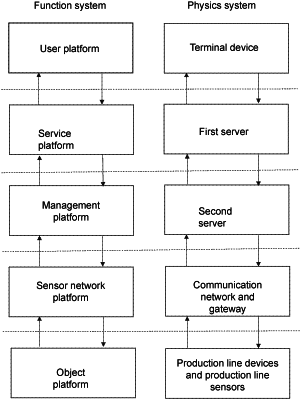| CPC G05B 19/41835 (2013.01) [H04L 67/12 (2013.01); G05B 2219/31368 (2013.01); G06F 18/24 (2023.01); G06Q 50/04 (2013.01); G16Y 10/25 (2020.01); G16Y 40/30 (2020.01)] | 18 Claims |

|
1. An industrial internet of things (IIoT) system for intelligent production control, comprising:
a user platform, a service platform, a management platform, a sensor network platform, and an object platform that interact in turn;
wherein
the user platform is configured as a terminal device, and interacts with a user;
the service platform is configured as a first server, receives instructions from the user platform and sends the instructions to the management platform, extracts information required by the user platform from the management platform, processes the information, and sends the information to the user platform;
the management platform is configured as a second server, controls the operation of the object platform, and receives feedback data from the object platform;
the sensor network platform is configured as a communication network and a gateway, through which the object platform and the management platform interact;
the object platform is configured as production line devices and production line sensors that perform manufacturing;
wherein
the service platform, the management platform, and the sensor network platform all use centralized layouts, the centralized layouts mean that any platform uniformly receives data, uniformly processes data, and uniformly sends data;
when the terminal device modifies production line parameters based on an instruction of the user, the terminal device generates a first instruction and sends the first instruction to the first server;
the first server processes the first instruction to generate a second instruction and sends the second instruction to the second server, the second instruction being used to be identified by the second server;
the second server modifies work order parameters stored in the second server based on the second instruction, generates a third instruction based on the modified work order parameters, and based on production link data of a plurality of production links in a production cycle of a product collected by the object platform, determines a judgment result of whether a device corresponding to each of the plurality of production links is abnormal by an abnormal determination model wherein the second server is further configured to:
construct an initial product comparison model including a first initial product feature extraction layer, a second initial product feature extraction layer, and an initial product judgment layer, wherein the initial product judgment layer determines whether a product output by the first initial product feature extraction layer and a product output by the second initial product feature extraction layer are the same product based on product feature vectors of the two products, the first initial product feature extraction layer and the second initial product feature extraction layer having shared parameters; and
obtain a trained product comparison model by training the initial product comparison model based on a plurality of training samples, wherein each of the training samples including historical product data of two products, a label is whether the two products are the same product;
wherein a first product feature extraction layer and a second product feature extraction layer are used as the product feature extraction layer of the abnormal determination model; and
when the second server sends the third instruction to the object platform through the sensor network platform, the object platform executes manufacturing and collects the production line data based on the third instruction.
|